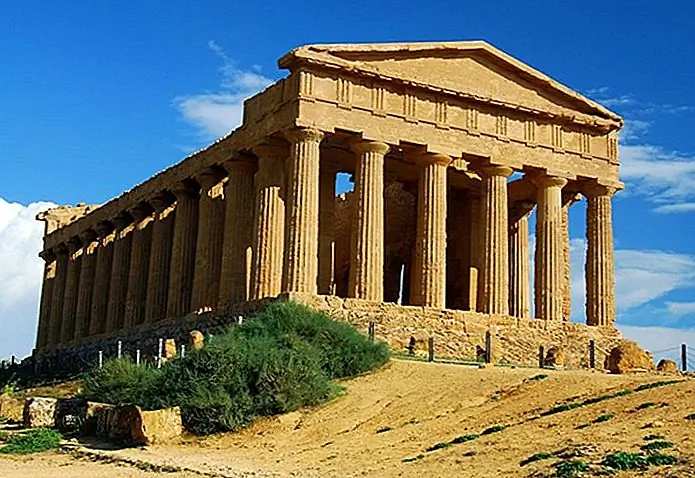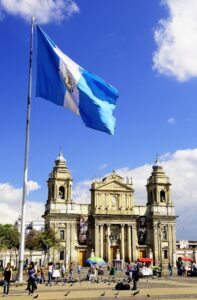Agrigento is located in a hilly landscape, very close to the southern coast of Sicily, and because of its beautiful temple ruins, it is one of the most rewarding cities in Sicily to visit. The many old buildings stand in vivid contrast with the modern high-rise blocks, which dominate especially in the southern part of the old city. In addition to these testimonies of antiquity, there are also buildings from both the medieval and Baroque periods that are worth seeing. Beaches are just a short distance away at Lido San Leone and at Porto Empédocle. Agrigento’s main tourist attractions from the Christian era are located in the current city center, between the train station and the cathedral. Those dating back to ancient times,
1 Temple of Concordia
Temple of Concordia
The Valley of the Temples, listed as a UNESCO World Heritage Site, dates back to 500 BC and consists of a series of temples, cemeteries and tombs. Three of the temples in the eastern group are lined up together and illuminated at night. The best preserved of these, the Temple of Concordia, ranks with the Hephaisteion at Athens and the classical Temple of Hera at Paestum as the most perfect temples in the Greek world; it is the best preserved Doric temple in Sicily and reflects the scale of these ancient sacred buildings. The temple was built around 425 BC in classical proportions with six columns on each of the two parallel sides and 13 on the other two. Even the interior follows the style that was the norm in Greece, without the adytum, which was usually found behind the cella in Sicily. Stairs to the left and right of the cella entrance lead to the roof truss and the building is preserved up to the roof. This is because in the sixth century it was converted into a Christian church with the cella as a central aisle and the columns were walled. The church was abandoned in 1748 and the building has been restored to its original temple appearance.
Adres: Valley of the Temples, Agrigento
Read also: top tourist attractions in Sicily
2 The temple of Juno in Lacinia

Temple of Juno Lacinia
The Temple of Juno (in Greek Hera), Lacinia, is located at the top of the eastern row of temples and has a circular hall of six by 13 columns. Of the columns, 25 are still standing. The cella was a room without inner columns. It got its marble floor later, probably in Roman times. Its religious symbolism is no longer evident, so it is unknown which deity was worshiped here. The temple was destroyed by the Carthaginians and, after being rebuilt by the Romans, was given a ramp leading to the eastern entrance side. From here you can see the remains of a large sacrificial altar.
Adres: Valley of the Temples, Agrigento
3 Temple of Olympian Jupiter (Tempel van de Olympische Zeus)

One of the western temples, dedicated to Zeus, is today a huge mass of broken blocks and pillars scattered over an area of 6,000 square meters by an earthquake. It is difficult to form an image of the building in its original state without plans or the proposed reconstruction provided by the Archaeological Museum, but it was clearly the largest of the temples. Built in 480 BC. Commemorating Theron’s victory over Carthage, it is the largest of all known Doric temples and occupies an area of 56.3 meters by 113.45 meters, with seven columns on each of the narrow sides and 14 on the longer sides. These were approximately 18.2 meters high and 4.05 meters in diameter at the base. Architecturally it was unlike any other known Greek temple, with the spaces between the columns walled approximately halfway up the height of the columns. Above the wall in niches were 38 gigantic figures with a height of 7.65 meters, one of which is in the Archaeological Museum and one copy on the temple. They supported the entablature with pediments decorated with reliefs six meters high, bringing the estimated height of the temple to about 40 meters.
Adres: Valley of the Temples, Agrigento
4 Temple of Castor and Pollux (Tempel van Castor en Pollux)

To the west of the Olympia extends a vast area dating back to the Sicans and expanded by the Greeks in the sixth and fifth centuries BC. The temple of Castor and Pollux in the north-west corner has four columns and a fragment of entablature and pediment, rebuilt between 1836 and 1871. It had colonnades of six by 13 pillars and belonged to the last phase of construction when the Greeks wanted to place their stamp in the area with something more impressive than the small older religious buildings.
Adres: Valley of the Temples, Agrigento
5 Tempio di Heracles (Temple of Hercules)

This circular Doric temple was built around 500 BC, with an extensive floor plan and dimensions of six by 15 pillars. The temple was destroyed by the Carthaginians in 406 BC, rebuilt by the Romans and then destroyed again by an earthquake. Even in the ruins it is still possible to see that behind the cella entrance there were stairs on either side giving access to the roof story. The fact that eight pillars of the south clinic are still standing is thanks to the Englishman Alexander Herdenstel, who carried out restoration work at his own expense in 1923. The original dedication of the temple is unknown, but in Roman times it was dedicated to Hercules.
Adres: Valley of the Temples, Agrigento
6 Regional Archaeological Museum
The Regional Archaeological Museum is one of the most modern museums in Sicily and contains important archaeological finds from the provinces of Agrigento and Caltanissetta dating from prehistoric times to Roman times. Among the collections are finds from the Neolithic, Bronze and Iron Ages and ancient finds from Gela and the necropolis at Montelusa, the oldest known tombs in the area. Highlights to look for include a fifth-century BC red-figured Greek krater from Gela depicting an Amazon battle, black and red-figured pottery from Athens and Italy dating from the sixth to third centuries BC, capitals and gargoyles with lion heads from several temples and the marble statue of an ephebe from about 480 BC.
Address: Contrada St. Nicola, I-92100 Agrigento
7 cathedral

The cathedral in Agrigento was built in the 11th century by the Normans on the highest point of the site of the ancient Acropolis, where the temple of Zeus Atabyrios once stood. In the 13th and 14th centuries the cathedral was expanded and in the 17th century it was renovated in the Baroque style. Next to the massive bell tower (note the ornate balcony), a grand staircase leads to the grand doorway. The interior of the three-aisled basilica was restored after the earthquake damage in 1966 and during this process an attempt was made to restore the original medieval atmosphere in the nave, retaining from the later changes only the beautiful 1518 wooden ceiling – the highlight of the church – and some of the opulent Baroque decorations in the choir. Look in the Gothic chapel in the right side aisle,
Address: Via Duomo, Agrigento
8 San Biagio
At the eastern end of the 351 meter high Rock of Athena (Rupe Atenea), this small church was built in the 12th century under Norman rule using materials salvaged from earlier buildings. It stands on the site of the Temple of Demeter, which is said to have been built about 480-460 BC. You can still see the foundations and parts of the north wall of this temple behind the apse of the church. Also look for two circular altars in the north of the building, which may have served as sacrificial sites. Ritual vessels have been found within these altars, making it possible to identify the sanctuary. You can follow a staircase down to the rock shrine of Demeter and Persephone, carved into the steep slope of Rupe Atenea. The oldest known place of worship in Agrigento, is thought to date back to pre-Greek times in the seventh century BC. Behind a narrow chamber in the rocks are two caves with springs whose water is led through several basins to the courtyard.
Address: Viale della Vittoria, Agrigento
9 Holy Spirit

The facade of the former Cistercian monastery of Santo Spirito, dating from around 1260, still retains the original Gothic ogival doorway and a rose window, the top of which ends in a Baroque facade. Inside, the walls are decorated with Baroque high reliefs in stucco, attributed to Giacomo Serpotta and completed in the 17th century. To the right of the church is a doorway leading to the remains of the monastery and to the beautiful door of the chapter house, a pointed arch with decorative Arabo-Norman windows. In the adjacent monastery you can buy biscotti and shell-shaped cookies, conchiglias from the nuns, which they make from local pistachios using the ancient methods and recipes.
Address: Via Santo Spirito, Agrigento
10 San Lorenzo

The beautiful facade of this 18th century church is in reddish-gold tuff with a white doorway framed in turned columns. Inside are deep relief stuccowork done in the late 1600s by Giacomo Serpotta, one of the masters of the Sicilian Baroque style.
Adres: Purgatory Square, Agrigento
Where to Stay in Agrigento for Sightseeing
We recommend these highly rated hotels near the city and the Valley of the Temples:
- Hotel Villa Athena: boutique luxury, Valley of the Temples location, elegant decor, temple views, inviting pool and spa.
- Colleverde Park Hotel: mid-range prices, near the temples, beautiful gardens, overlooking the valley, friendly service.
- Exclusive hotel: affordable boutique hotel, near the city center, great staff, modern decor, clean rooms.
- B&B Liola: cheap bed-and-breakfast, in town, great hosts, home away from home, great breakfast.
Day trips from Agrigento
Scala dei Turchi (Stairs of the Turks)

This white rock cliff on the coast near Porto Empedocle is formed by marl, a sedimentary rock similar to limestone, whose layered composition causes it to erode in regular step-like layers. It gets its name, Stairs of the Turks, from the frequent raids by Turkish pirates, who found the steps an easy way to climb ashore. These striking white cliffs lie between two beaches, which, combined with their mention in Andrea Camilleri’s Commissario Montalbano series, have made them a popular attraction for tourists. The marl sand is also a favorite mud bath, known to benefit the skin. The cliffs change color at different times of the day, from bright white in the midday sun to golden and light at sunset.
Location: Realmonte Agrigento
Sciacca

Sciacca
This small fishing port on the south-west coast is situated on a hill above the harbor and has been a popular spa town since Roman times. Apart from the charms of the old streets, the highlights are three churches. The Chiesa del Carmine , which stands next to the 16th-century Baroque city gate, is a triple-aisled Gothic basilica with its original rose window and a later Baroque portal. The 12th-century cathedral has a 16th-century façade and inside is a multi-sectioned marble tabernacle attributed to the Renaissance painter Antonino Gaggini depicting the Passion of Christ. West of the cathedral, the displaced Chiesa Santa Margheritawas endowed in 1342 and preserves the front door of the original Gothic building. It was rebuilt in 1595 when the rich stucco decoration was added. Not far from the city gate of Porta San Calägero, you will find the outer walls and a tower from the 14th century Castello dei Luna . Sciacca’s most unusual attraction, however, is located about two kilometers east of the city on Via E. Ghezzi. The Castello Incantato was created by Filippo Bentivegna, who carved thousands of heads – devils, knights, gods and historical figures – from the rocks behind his house in the early 1900s.
Read also:
top tourist attractions in Syracuse





